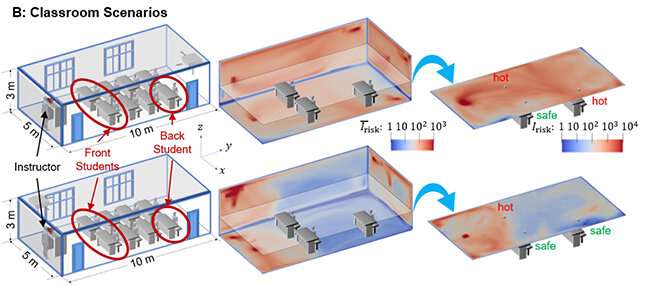
A new study from the University of Minnesota College of Science and Engineering analyzes how the coronavirus spreads indoors—information that could help businesses and schools take precautions to reduce the chance of COVID-19 transmission as they reopen.
Mechanical engineering associate professor Jiarong Hong and assistant professor Suo Yang modeled the airborne virus transmission through aerosols, which are ejected from our mouths when we exhale or speak. The researchers found that when an infected person does this, the SARS CoV-2 virus hitches a ride on those aerosols as they land on nearby surfaces or are inhaled by another person.
Using precise experimental measurements of aerosols released by eight asymptomatic individuals with COVID-19, the researchers were able to numerically model the external flow of the virus through the air in three interior spaces—an elevator, a classroom, and a supermarket. Then, they compared how the virus faired among different levels of ventilation and with different spacing among the rooms’ occupants.
“In general, this is the first quantitative risk assessment of the spatial variation of risks in indoor environments,” Hong said. “You see a lot of people talking about what the risks are of staying in confined spaces, but nobody gives a quantitative number. I think the major contribution we’ve made is combining very accurate measurements and computational fluid dynamics simulation to provide a very quantitative estimate of the risks.”
The researchers found that in indoor spaces, good ventilation will filter some of the virus out of the air, but may leave more viral particles on surfaces. In the classroom setting, after running a 50-minute simulation with an asymptomatic teacher consistently talking, the researchers found that only 10 percent of the aerosols were filtered out. The majority of the particles were instead deposited on the walls.
“Because this is very strong ventilation, we thought it would ventilate out a lot of aerosols. But, 10 percent is really a small number,” said Yang, who holds the Richard and Barbara Nelson Assistant Professorship in Mechanical Engineering. “The ventilation forms several circulation zones called vortexes, and the aerosols keep rotating in this vortex. When they collide with the wall, they attach to the wall. But, because they are basically trapped in this vortex, and it’s very hard for them to reach the vent and actually go out.”
In each scenario, the researchers mapped the air flow to find locations of virus “hot” spots, or where the aerosols congregated. With the right combination of ventilation and interior organization, it could be possible to mitigate the disease spread and avoid these hot zones, the researchers said.
For example, in a classroom setting, the virus aerosols spread significantly less throughout the room when the teacher—who is likely doing the most talking—was placed directly under an air vent. This insight could inform how classrooms are arranged and disinfected, and also help places like theaters and concert venues reopen with the proper precautions.
Yang and Hong recently began working with the Minnesota Orchestra to measure aerosol concentrations and flow while instruments are played onstage at Orchestra Hall. Eventually, they hope to provide the nonprofit with a plan to minimize the COVID-19 risk in Orchestra Hall.
“After our work goes out, I think more people will ask for help because I think many businesses reopening will have this need—movie theaters, drama theaters, any place with large gatherings,” Yang said. “If you do a good job, if you have good ventilation at the right location, and if you scatter the seating of the audience properly, it could be much safer.”
The researchers recently joined an international work group of experts led by University of Minnesota Professor Michael Osterholm of the Center for Infectious Disease Research and Policy. The task force’s goal is to learn how much of the SARS CoV-2 virus it takes to become infected and provide science-driven policy that will help mitigate the COVID-19 pandemic.
In addition to Hong and Yang, members of the research team include postdoctoral researcher Dezhi Zhou (mechanical engineering); Ph.D. students Santosh Kumar, Shufan Zou, Siyao Shao, Ruichen He, and Jiaqi Li (mechanical engineering); and mechanical engineering alumnus Kevin Mallery (B.S. ’14, Ph.D.’20). This research relied heavily on the work and dedication of these students, most of whom paused other projects to focus on this one, the researchers said.
More information: Shao et al., Risk assessment of airborne transmission of COVID-19 by asymptomatic individuals under different practical settings. arXiv:2007.03645 [physics.med-ph]. arxiv.org/abs/2007.03645
No comments:
Post a Comment
Note: Only a member of this blog may post a comment.